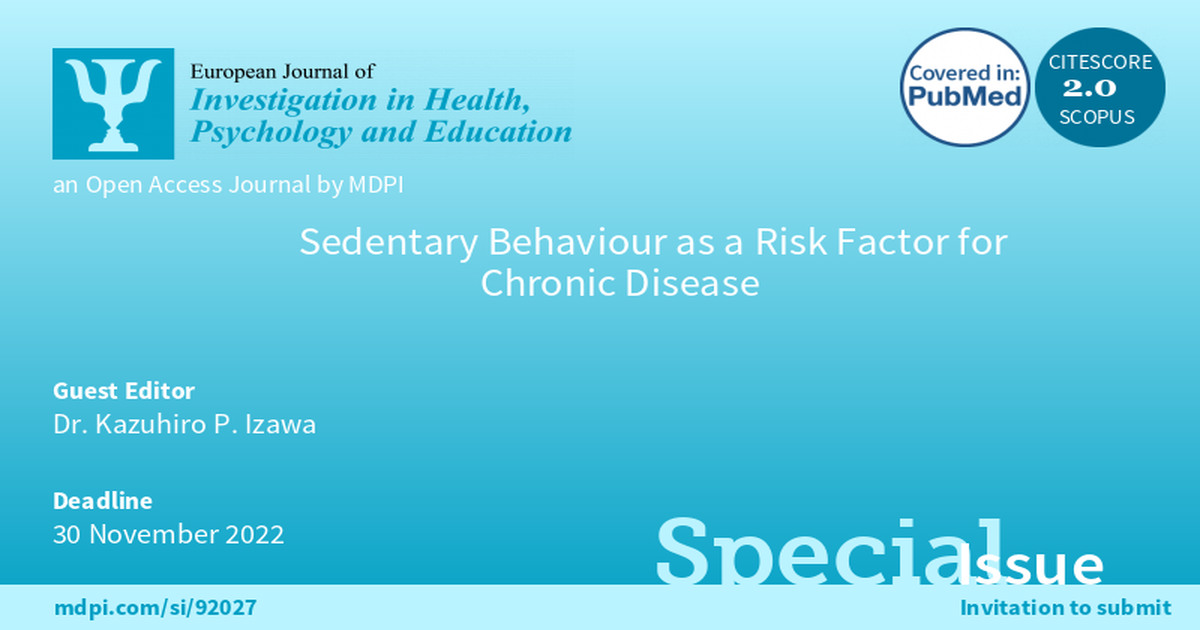Sedentary Behaviour as a Risk Factor for Chronic Disease
A special issue of European Journal of Investigation in Health, Psychology and Education (ISSN 2254-9625).
Deadline for manuscript submissions: closed (30 November 2022) | Viewed by 16957

Special Issue Editor
Interests: exercise; adherence; physical activity; disease management; sedentary behavior; health related quality of life; mortality; mobidity; environment; cost effectiveness
Special Issues, Collections and Topics in MDPI journals
Special Issue Information
Dear Colleagues,
It has been pointed out that obesity, hypertension, dyslipidemia, smoking, pollination of alcohol, etc. increase the number of various affected people. In addition, malnutrition tends to cause physical activity reduction, weight loss, muscle weakness, body fat reduction, and eventually infectious diseases. On the other hand, maintenance and improvement of physical activities are effective not only for the prevention and improvement of diseases such as obesity, diabetes, hypertension, cancer, infectious diseases, but also for preventing prevention and deterioration of falling into a state requiring nursing care. However, even if physical activity is performed periodically, those with sedentary behavior (too much sitting) may increase various health risks (total death, obesity, diabetes, heart disease, etc.).
This Special Issue is not only looking for papers reporting original data from epidemiologic studies, but also systematic reviews and meta-analyses.
Dr. Kazuhiro P. Izawa
Guest Editor
Manuscript Submission Information
Manuscripts should be submitted online at www.mdpi.com by registering and logging in to this website. Once you are registered, click here to go to the submission form. Manuscripts can be submitted until the deadline. All submissions that pass pre-check are peer-reviewed. Accepted papers will be published continuously in the journal (as soon as accepted) and will be listed together on the special issue website. Research articles, review articles as well as short communications are invited. For planned papers, a title and short abstract (about 100 words) can be sent to the Editorial Office for announcement on this website.
Submitted manuscripts should not have been published previously, nor be under consideration for publication elsewhere (except conference proceedings papers). All manuscripts are thoroughly refereed through a single-blind peer-review process. A guide for authors and other relevant information for submission of manuscripts is available on the Instructions for Authors page. European Journal of Investigation in Health, Psychology and Education is an international peer-reviewed open access monthly journal published by MDPI.
Please visit the Instructions for Authors page before submitting a manuscript. The Article Processing Charge (APC) for publication in this open access journal is 1400 CHF (Swiss Francs). Submitted papers should be well formatted and use good English. Authors may use MDPI's English editing service prior to publication or during author revisions.
Keywords
- frailty
- sarcopenia: Covid-19
- exercise training
- adherence
- physical activity
- disease management
- sedentary behavior
- chronic disease
- health-related quality of life
- mortality
- morbidity
- environment
- apathy
- cost-effectiveness
- cognitive function
Benefits of Publishing in a Special Issue
- Ease of navigation: Grouping papers by topic helps scholars navigate broad scope journals more efficiently.
- Greater discoverability: Special Issues support the reach and impact of scientific research. Articles in Special Issues are more discoverable and cited more frequently.
- Expansion of research network: Special Issues facilitate connections among authors, fostering scientific collaborations.
- External promotion: Articles in Special Issues are often promoted through the journal's social media, increasing their visibility.
- e-Book format: Special Issues with more than 10 articles can be published as dedicated e-books, ensuring wide and rapid dissemination.
Further information on MDPI's Special Issue polices can be found here.






